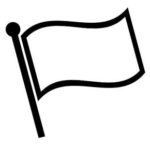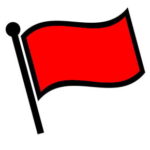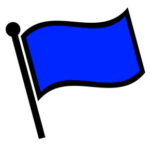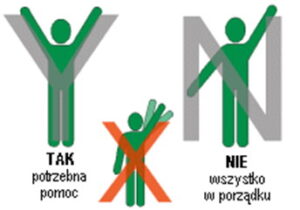Calling for help
If you’re calling the emergency number 112, calmly and clearly tell:
- What happened
- Whether there are any victims – if it’s true, report the number and their conditions – are they still breathing, are they conscious, what kind of injuries do they have
- Specify the location – if the address isn’t known to you, describe the characteristic points, landscape elements etc. Give other important information about the incident
- Identify yourself - give your name, the phone number you are calling from
Don’t block the emergency number with cases that can be handled in different ways.
Remember! Do not hang up first, the dispatcher always hangs up first!
If you’re at home in an emergency situation and need help, display the flags (or material in an appropriate colour)
 |
Need for evacuation! |
 |
Need for medical help! |
 |
Need for food and water! |
Notification for helicopter rescue crew

Don’t approach the helicopter! The rescuers will get close to you.
Calling for help in the mountains
If you don't have a usable mobile phone and you’re all alone, use a method with over 200 years of history.
Alpine signal:
- It may be an audible or optical signal
- Transmit it at a frequency of 6 times per minute, every 10 seconds
- Then, wait a minute for a possible answer
- Broadcast the alarm signal again and wait 1 minute for the answer again; repeat the steps until you get the answer
- The feedback signal should be twice as slow - a flash or sound every 20 seconds
- You can give the signal with a whistle, mirror, camera flash, improvised instrument, shout or a flashlight
Moreover, you can light a fire - noticed in a national park should alert that someone is calling for help.
Calling for help away from civilization and people
Imagine that your phone doesn’t work and you’re high up in the mountains, away from any inhabited places, or even in a desert. There’s still a chance to survive. Below, you can find methods of calling for help:
- Transmit signals with a mirror. If you don't have a mirror, use another shiny object, e.g. a polished mug or a piece of metal. Such flash sent in the direction of an airplane can be visible even from a distance of several dozen kilometres. In the open air, the higher you stand, the more visible the signal will be
- Light up 3 fires in a triangle-like shape - prepare and protect it from getting wet or unwrapped. When you hear approaching plane or helicopter light it up quickly. Signal fires are the better, the more they smoke, so that gather green twigs, moss, oil - anything that fumes
- Spread out possibly large pieces of coloured fabric or NRC foil – they’re clearly visible from the air
- If a helicopter is already approaching, give the pilot a Y or N signal depending on whether you still need help or not
Calling for help at sea
In a life-threatening situation, we call for help in several possible, most effective ways.
Satellite communication:
- You call for help by activating the salt water EPIRB (Emergency Position-Indicating Radio Beacon), a radio transmitter that allows you to determine the location of your boat in an emergency, sending an alarm signal to the satellite, which then goes to the nearest SAR (Search & Rescue) unit
- The EPIRB's supplementary device is the SART (Search And Rescue Transponder) radar transponder, which should be activated together with the radio beacon. When the SART is traced by the search unit's radar, it starts sending an alarm signal
Radio communication:
The Global Maritime Distress and Safety System (GMDSS) provides connectivity from any place in the world to coastal stations, with a subsystem equipped with VHF radios (Very High Frequency), popularly known as UKF.
Four categories of messages in use:
- DISASTRESS – called in danger (MAYDAY)
- URGENCY – urgent call (PAN-PAN)
- SAFETY- safety call (SECURITE)
- ROUTINE – routine communication call
The algorithm of calling for help by UKF e.g. on channel 16:
MAYDAY MAYDAY MAYDAY
THIS IS (unit name) 3 times repeated
MMSI (individual radio station number)
POSITION (latitude and longitude)
(situation description)
I REQUIRE IMMEDIATE ASSISTANCE
(additional information)
OVER
Signalling devices – pyrotechnics:
If you can't make use of a satellite or a radio device, choose classic methods. Remember that you have limited resources, so that use them only when there’re other units on the horizon.
- Flare (red torch) - basic pyrotechnic element on the yacht. After firing, it gives a very bright red light for about 60 seconds. It should be held in the hand on the leeward side. Don't look at the flame, because it may cause loss of sight
- Parachute rocket - fired into the sky flies at a height of about 250-300m and burns with a bright red light for at least 45 seconds. The rocket should be fired slightly upwind, so that after it’s lifted upwards it's above us
- Smoke-crowded rods – a rod that gives a thick orange smoke. Throwing it into the water will help the pilot to determine the wind at the water surface
Unconventional emergency measures, not only at sea:
You can use the following methods to call for help at sea.
- Flashlight - stagger large circles with the flashlight facing the direction you’re calling for help
- SOS (Save Our Souls) - you can give a signal by light or sound, in a sequence of 3 short / 3 long / 3 short
- Mirror - reflect the sun's rays in a mirror facing the direction you’re calling for help
- Hands - slowly and repeatedly raise and lower both arms straight up and down once
- Signal trumpet - start honking continuously


